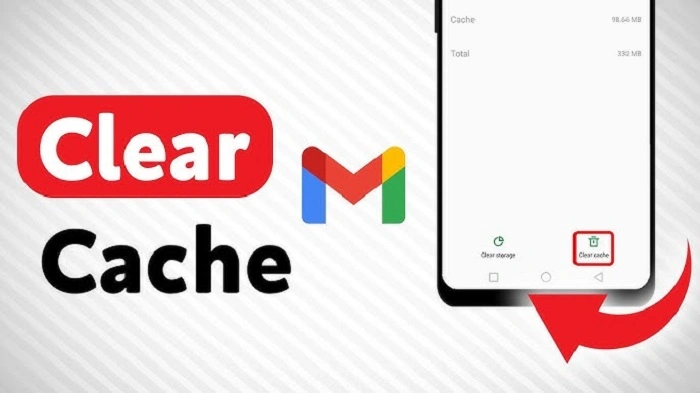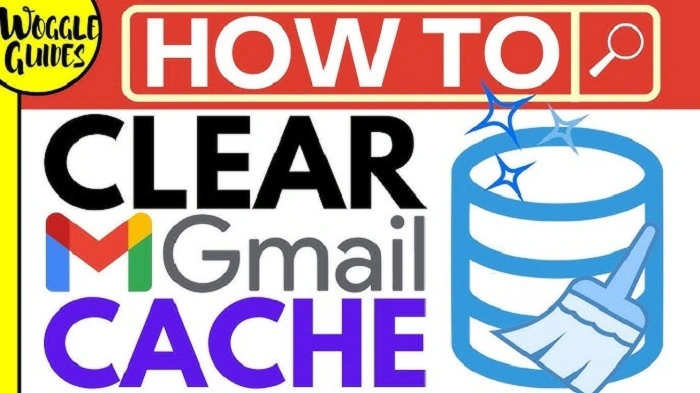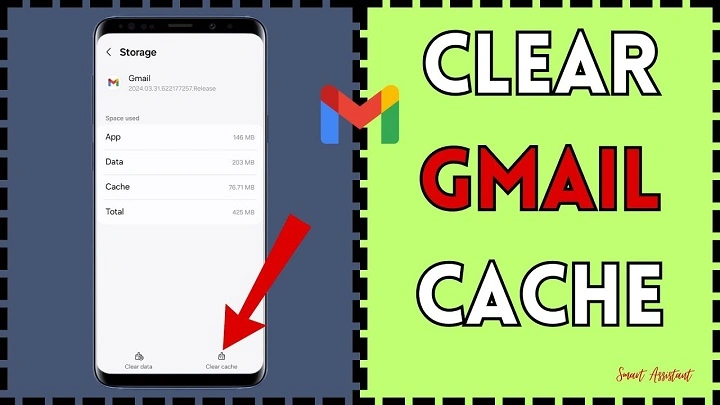Gmail just won’t cooperate sometimes. Maybe it won’t even launch, attachments won’t open, you can’t send mail, or you’re trapped with limitless copy-old duplicate drafts that you really did delete. It isn’t actually Gmail — most likely, it’s the cache.
Your browser and app store a local cache of Gmail content (images, scripts, cookies) so that it loads quicker on the second occasion. But it all adds up over time. When it is too big or too old, Gmail crashes.
The bright side? Nearly all but Gmail apocalypse-level problems are fixed with clearing cache. It’s instant, only takes a few minutes at most, and speeds up your inbox and wipes it out in a snap.
In this tutorial here, we will walk you through removing Gmail cache in Chrome, Safari, Firefox, Android, and iPhone. You will also learn why you should delete the cache, what you are deleting, and how you can have Gmail in good shape the next time.
What Is Gmail Cache
Gmail cache is a cache area where your mobile app or browser holds part of Gmail in memory.
It stores:
- Images and icons in your mail inbox
- Login credentials and cookies
- Offline mail data (cached, if any)
- Searches and drafts
- JavaScript files Gmail loads dynamically
That is why Gmail loads fast because it doesn’t have to re-download everything all over again each time you open it up.
But the instant that cache expires or even gets corrupted to such an extent, Gmail takes a lifetime or even gobbles up forever.
Gmail cache flush re-installs all in order for Gmail to start from scratch.
Why Flush Gmail Cache

You may not be aware of how much Gmail cached data slows down performance until it is flushed.
After cache flushing:
- resolves load issues: Gmail loads rapidly and seamlessly.
- resolves glitches: Buttons, attachments, and menus work as usual.
- capture storage space: Cache takes up a few hundred megabytes.
- reshuffles Gmail interface: New design files overwrite old ones.
- preserves privacy: Erases login and session history on public computers.
If Gmail is sluggish or even still displays you older emails, the first thing to try is clear cache.
What Is Clearing Gmail Cache
We are all scared that clearing cache will erase their emails — it will not. Here is what it does:
✅ Your Gmail messages, labels, and attachments remain with Google servers.
✅ Gmail filter, contacts, and settings are not affected.
???? What gets cleared are local saved temporary files — the ones your Gmail app or your browser is temporarily storing.
So clearing cache, once Gmail logs out, it will take slightly longer to reload for two seconds, and then simply operate as usual later.
How to Clear Gmail Cache on Google Chrome
Since we all use Gmail through Chrome, let’s begin there.
Step 1: Open Chrome Settings
Open Chrome on your device.
Tap the three dots (⋮) in the top right.
Tap Settings.
Step 2: Go to Privacy and Security
In the left-hand menu, tap Privacy and security.
Tap Clear browsing data.
Step 3: Choose What to Clear
In the pop-up, tap the Advanced tab.
Choose the Time field to All time (to start from the beginning).
Select these boxes:
- Cookies and other site data
- Cached images and files
Make Passwords blank if you’re okay with logging off everywhere.
Step 4: Clear Data
Tap Clear data.
Chrome will clear Gmail’s cached data. When you next access Gmail, it’ll reload from scratch — new, quick, and current.
How to Clear Gmail Cache in a Particular Chrome Profile
In the situation that you possess multiple Chrome profiles (school, work, and home, for instance), clearing the cache would just delete the one you are currently logged into.
To delete the proper Gmail:
Find your Chrome profile icon in top-right.
Switch to right profile.
Do above then.
Each profile contains its own cache, cookies, and Gmail settings.
Clearing Gmail Cache in Firefox
Open Firefox.
Click on menu button (≡) top-right.
Select Settings.
Click on Privacy & Security.
Click on Cookies and Site Data.
Click on Clear Data.
Select Cached Web Content.
Click Clear.
Reload Gmail after cleared. You may need to log in again, but your inbox will be faster.
How to Clear Gmail Cache on Safari (Mac)
Open Safari.
Click Safari → Preferences in top menu.
Click to tab Advanced.
Check the option Show Develop menu in menu bar.
Close Preferences.
Click Develop → Empty Caches.
Now Safari clears all site caches, including Gmail’s.
To clear cookies as well:
Go to Safari → Clear History → All History → Clear.
Then open Gmail. It’ll be clean like it’s the first time.
How to Clear Gmail Cache on Microsoft Edge
Open Microsoft Edge.
Click the three dots (⋯) top-right.
Click Settings.
Click Privacy, search, and services.
Clicking the Clear browsing data at the bottom, click Choose what to clear.
Cached images and files and Cookies.
Click Clear now.
Edge will clear Gmail cache immediately. Refresh Gmail later and observe the difference.
How to Clear Gmail Cache on Android
If you are opening with the Android Gmail app, sure, that has a local cache as well. Clearing that may resolve syncing issues, blank page issues, or attachment issues.
Steps:
- Open phone settings.
- Tap Apps.
- Swipes down and locate Gmail.
- Tap Storage.
- Tap Clear Cache.
If your Gmail is still not working, you can also tap Clear Data. That’s what it will do, it wipes the app out, but your emails are all fine online.
Close the app and log in once more, and it will re-download new data.
How to Clear Gmail Cache on iPhone or iPad
You can’t clear app cache as in Android. You can, however, force Gmail to reload its data either from the application or Safari.
Option 1: Uninstall and Reinstall Gmail App
Long tap Gmail icon.
Remove App → Delete App.
Reinstall Gmail from App Store.
This removes all the cache information and re-installs Gmail fresh.
Option 2: Clear Safari Cache (for Gmail web)
Access Settings.
Scroll down → Tap Safari.
Tap Clear History and Website Data.
Safari now forgets Gmail’s stored cache. The next time you sign in to Gmail, it will download everything again from scratch.
How to Delete Gmail Offline Cache (If Gmail Offline is Enabled)
If you’ve enabled Gmail Offline, Gmail deploys a special cache on your device so you can view emails offline.
How do I delete it:
Open Gmail.
Tap on the gear icon (⚙️) → See all settings.
Tap on the Offline tab.
Don’t tap on Enable offline mail.
Tap on Save changes.
This deletes Gmail offline cache from your device. To disable offline mode but delete it, disable it later — Gmail will automatically build a new cache.
How to Delete Gmail Cache from Google Account Settings
Google keeps cookies and web histories across products (Gmail, Drive, YouTube, etc.). You can delete all of them at once.
Go to myactivity.google.com.
Sign in.
Press Delete activity by.
Choose All time.
Choose Gmail and any other service you want.
Press Delete.
This will delete Gmail’s app data cache like suggestions and search history.
How to Force Gmail to Reload Without Cache
You don’t always have to delete all cache — you can reload Gmail without loading stored data.
On Windows:
Press Ctrl + F5 or Shift + Refresh.
On Mac:
Press Command + Shift + R.
This makes Gmail to download latest data directly from Google servers without traversing through any intermediary cached data.
It is an instant temporary solution for minor display issues.
Clear Gmail App Cache for Google Workspace Accounts
For Google Workspace work mail users, clearing cache also restores admin configurations or shared inbox issues.
For users or admins:
Open Chrome and sign in using your Workspace account.
Clear cookies and cache as outlined above.
Go to Admin Console → Apps → Google Workspace → Gmail.
Select Service status → Force refresh.
It will update Gmail locally and server-side too.
How Often Clear Gmail Cache
No one-size-fits-all answer, but here’s a quick summary:
- Every 1–2 months if you use Gmail constantly.
- As soon as possible if Gmail freezes, is slow, or shows old data.
- After major updates to restore Gmail to its look or design.
Think of it like dusting your desk — not every day, but frequently enough to keep it running.
How to Do When Clearing Gmail Cache
Once cleared cache, Gmail may:
- Log out once.
- Take slightly longer to load initially.
- Ask for permissions again (such as notifications).
After reloading, it will load faster, smoothly, and respond better.
To keep Gmail so:
- Don’t have multiple tabs open concurrently.
- Don’t install intrusive browser add-ons on Gmail.
- Upgrade your browser.
- Use Gmail’s built-in “Standard” view rather than “Basic HTML.”
These are the small habits that prevent future cache jamming.
Troubleshooting: Gmail Still Slow After Clearing Cache
- Disable Browser Add-ons
Some add-ons (ad-blockers or email trackers) are causing the problem. Turn them off and try again. - Flush DNS Cache
Your device can still retain outdated Gmail connection data in its cache.
On Windows: open Command Prompt → type ipconfig /flushdns → Enter.
On Mac: open Terminal → enter sudo killall -HUP mDNSResponder → Enter. - Clear Autofill and Site Data
Gmail occasionally stores autocomplete information somewhere other than in cache.
Open Chrome Settings → Privacy → Clear browsing data → Advanced → Site settings. - Reset Gmail Labs or Advanced Features
Temporarily disable experimental Gmail features in Settings → Advanced.
Gmail will be as fresh as possible after these steps.
How to Automatically Clear Gmail Cache

If you want your Gmail not to expire, then you can have Chrome clear cache on exit.
Steps:
- Open Chrome Settings.
- Select Privacy and security → Cookies and other site data.
- Select Clear cookies and site data when all windows close.
Whenever you close Chrome, it will automatically clear the Gmail cache.
This is fine for shared or group machines, but you have been warned that you will be logging in every time.
Also Read: How to Find Unread Emails in Gmail: Step-by-Step Guide
How to Clear Gmail Cache Without Deleting Cookies
If at all you would like to retain sign-in information but remove Gmail images:
Enter chrome://settings/siteData in the browser address bar.
Enter “mail.google.com.”
Select the trash can icon beside it.
This removes Gmail-specific cache without removing your whole browsing history or cookies from other websites.
Advantages of Clearing Gmail Cache Periodically
| Benefit | Description |
| Faster Gmail Load | Loads Gmail in seconds, not minutes. |
| More Storage Space | Cache files use up to 1 GB space. |
| Less Errors | Prevents “Something went wrong” or white pages. |
| Smarter New Features | Loads new Gmail layout and security patches. |
| Sweeter Browser | Don’t fiddle around with your browser. |
Clearing cache is not maintenance — it’s performance tweak.
Practical Scenarios Where Clearing Gmail Cache Is Useful
Scenario 1: Gmail will not load attachments.
→ Cache clearing allows Gmail to reload new file-handling scripts.
Scenario 2: The Gmail interface not functioning as expected after an update.
→ Newly added layouts blocking cached CSS files; clearing them instantly fixes the issue.
Scenario 3: Gmail continues to auto-fill incorrect contacts.
→ Clearing cookies and cache removes autofilled information saved.
Scenario 4: You’re using a shared PC and log in to Gmail with other individuals.
→ Cache clearing keeps your login credentials private from other users.
Scenario 5: Offline Gmail showing old messages.
→ Extreme offline cache clearing forces Gmail to reload with fresh data.
FAQs on Clearing Gmail Cache
Will mails be lost while clearing Gmail cache?
No. Your mails are safe on Google servers. Cache only removes temporary files.
Should I clear Gmail cache occasionally?
Every other two months or occasionally would be okay with most users.
Does clearing cache log out?
Yes, occasionally — particularly if you also delete cookies.
Is it like deleting Gmail data?
No. It will delete locally stored files only, not your messages in the inbox.
Can I delete Gmail cache for a machine only?
Yes. Cache deletion is per machine — deleting on one machine will not touch others.
If Gmail is slow, frozen, or not loading, the solution always boils down to one: clearing cache. It’s a big sigh of relief for Gmail — getting rid of old files, clearing space, and fresh starting its memory.
Now you flat out know how to tidy up Gmail cache on any of your devices — Chrome, Safari, Firefox, Android, and iPhone. And now you flat out know how to manage offline data, avoid future mayhem, and have a fast Gmail all year round.
Make tidying up the cache a little ritual, and Gmail will greet you with a fast, fast, and hassle-free inbox every time you sign in.

